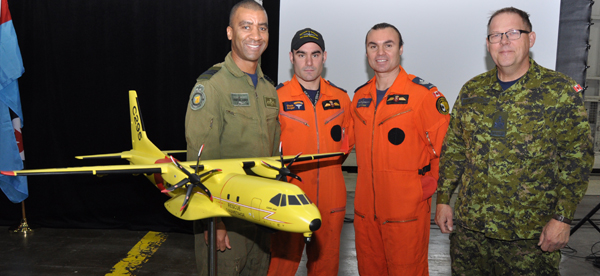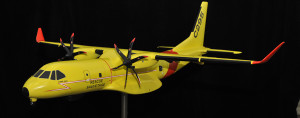New airbus unveiled for Search and Rescue
Administrator | Dec 12, 2016 | Comments 0

424 Transport and Rescue Squadron Commander Lt.-Col. Leighton James, Sar Techs MCpl. Chris Auger and Sgt. Gord Hynes, and Chief Warrant Officer Brian Wilson gather around the model of the Airbus C295W displayed during the announcement of the purchase of the new aircraft at 9 Hangar on CFB Trenton Thursday. Ross Lees photo
Photos and story by Ross Lees
Sixteen new Airbus C295W aircraft will help fulfill the Canadian military’s search and rescue (SAR) role.
The announcement was made at 9 Hangar at 8 Wing/Canadian Forces Base (CFB) Trenton, the home of 424 (Tiger) Transport and Rescue Squadron (TRS) by the Minister of Public Services and Procurement Judy Foote, Minister of Defence Harjit Sajjan and the Royal Canadian Air Force (RCAF) Commander Lieutenant-General (Lt.-Gen.) Michael Hood.

The new SAR C295W aircraft from Airbus Defence and Space was unveiled at 8Wing CFB Trenton Thursday. Photo by Ross Lees
The $2.4 billion contract includes the supply of the 16 aircraft for the four SAR bases in Canada – at Comox, BC, Winnipeg, Manitoba, Trenton, Ontario and Greenwood, Nova Scotia but includes maintenance and support programs, according to Minister Foote.
She called the SAR effort “an essential life-saving service for Canadians coast-to-coast-to-coast,” tasked to cover 18 million square kilometres over one of the most diverse and challenging environments in the world.
Sajjan called the new aircraft “a game changer,” noting it represents a great technological improvement of SAR capabilities for the future.
“This aircraft’s advanced integrated sensors and radar will allow crews to locate people in distress more easily, even in low-light conditions and in inclement weather. Its new mission management system will allow them to track up to 200 search objects at the same time,” he said during the announcement.
“Its cutting edge communication sweep will enable SAR crews to share real-time information with other aircraft, ships, ground search crews and the Joint Rescue Coordination Centres, whether it is in mountainous terrain, the middle of the Atlantic or over the Arctic. The C295 is the modern and versatile aircraft we need to continue to conduct search and rescue missions day and night and in all weather conditions,” he said.
Lt.-Gen. Hood was effusive with his praise of this new aircraft.
“I believe this new fleet with the capability to fully integrate with our search and rescue partners will fundamentally change the SAR paradigm for us. Thanks to the sensors and systems aboard this new fleet of aircraft, I believe search and rescue is going to become a lot less about search and a lot more about rescue, and that is very good news,” he said.
Delivery of the new aircraft will begin in 2019 and is scheduled to conclude in 2022 as phase one of the 11 years of the contract. At the same time, a new simulator-equipped training centre is to be built in Comox BC, which will use state-of-the-art technology to deliver a comprehensive training program, according to minister Foote.
A second phase of the contract covers the first five years of maintenance and support. The contract also includes options to support search and rescue aircraft and operations for an additional 15 years, which could extend the contract until 2042, and bring total value of the contract to $4.7 billion, she announced.
The aircraft are equipped with Pratt and Whitney Canada engines. CAE of Montreal is to provide the training and simulators for the aircrew.
The Airbus C295W replaces the Royal Canadian Air Forces’s 40-year-old Buffalo aircraft and even older C-130 H-models currently assigned to search and rescue duties.
424 Squadron Commander Lieutenant-Colonel Leighton James said he and his squadron members were looking forward to the future with this new SAR platform.
“We in the SAR community are looking forward to the many capabilities that come with this new platform. Canadians have a lot to look forward to when we master this new aircraft.” he said.
He acknowledged though, that with the change will come a steep learning curve.
“Change can be tough and I expect no different when we get this platform, but as a SAR CO, I’m definitely looking forward to the future,” he said.
As part of the proposal, Airbus Defence and Space committed to undertake business activities equal to the value of the contract in Canada, maximizing the economic benefits for Canadians, said Foote.
Filed Under: Featured Articles
About the Author:


































